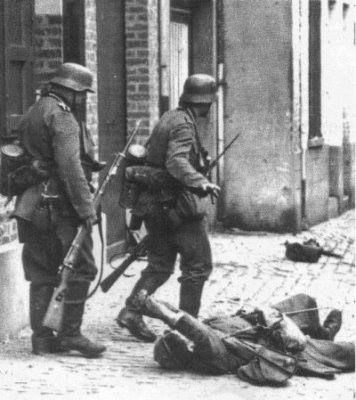Thursday 6 June 1940
 |
| Foredeck of the Scharnhorst, following a minesweeper. It is at sea off Norway along with sister-ship Gneisenau. |
The French line is in the most peril along the Somme between Amiens and the sea. There, XVI Panzer Corps of the 4th Army makes the largest gains in the entire offensive. General Erwin Rommel's 7th "Ghost" Panzer Division sidesteps the effective French artillery at Amiens and breaks through to the west of that city, advancing 20 miles between Abbeville and Amiens. This illustrates one of the inherent weaknesses of the "hedgehog" theory of defense, as there is no "line" to cross, but instead simply places to avoid. The 5th Panzer Division also makes good gains.
The 51st Highland Division at Saint-Valery-sur-Somme at the mouth of the Somme is in deep trouble, but it has the good fortune of being the closest portion of the line to England.. RAF Bomber command supports it with a raid of 38 bombers.
Further east, between Amiens and Peronne, von Kleist's Panzer Group is held. To the east of Kleist's troops, Panzer Group Guderian seize bridgeheads across the Aisne.
The French 10th Army, 7th Army, and 6th Armies are withdrawing under pressure. The French are using their 75mm field guns as anti-tank artillery, just as the Wehrmacht uses its 88 mm anti-aircraft guns in the same role. Firing at panzers over open sights is a dangerous occupation, but even the best panzers are susceptible to direct hits.
About 109,000 French troops evacuated to Great Britain pursuant to Operation Dynamo demand to be sent back to France to defend their country.
 |
| A short-barreled Panzer IV in France, May/June 1940 (Eckert, National Archive). |
The RAF Bomber Command sends 24 bombers to attack Hamburg and other German targets during the night, and 41 aircraft to attack German lines of communication for the troops at the front.
Battle of the Atlantic: U-46 (Oberleutnant zur See Engelbert Endrass) torpedoes British 20,277-ton armed merchant cruiser (converted liner) HMS Carinthia west of Galway Bay, Ireland at 01:13. The Carinthia is in bad shape but remains afloat at day's end.
German minesweeper M-11 hits a mine and sinks off of Norway.
British ship Harcalo hits a mine and sinks in the English Channel near Dover.
German raider Atlantis is back in the south Atlantic, disguised as Dutch freighter MV Abbekerk. It stops and captures 7,230-ton Norwegian freighter Tirranna. Five of the crew perish. The ship is taken as a prize but retained in the area due to a lack of fuel.
Norwegian submarine B.3 departs from Harstad for Tromso but experiences an explosion which cripples it. The submarine lays up in Gavlfjord near Tromso.
German raider Thor sails toward the Atlantic for a mission.
The Italian Navy begins laying mines.
Norway: The Royal Navy continues evacuating troops from Narvik, some 5,200 today from Harstad. The aircraft carrier HMS Glorious is approaching to recover the RAF aircraft at Bardufoss - which will eliminate Allied air cover.
German Military: The Germans are discriminating amongst their Belgian prisoners of war depending upon their language. Flemish prisoners are released, while French speakers are sent to German POW camps.
French Government: Prime Minister Paul Reynaud warns his Cabinet that he may withdraw the government to French possessions in North Africa to continue the struggle, if necessary.
British Government: The new British Ambassador to Moscow is Sir Stafford Cripps, well known for his socialist views.
Italy: Mussolini - with the King's assent - orders long-time military Chief of Staff Pietro Badoglio to prepare for war with France and Great Britain.
China: At the Battle of Tsaoyang-Ichang, the Japanese 11th Army captures Chingmen, Shihlipu, and Shihhuichiao.
Japanese bombers launch another attack on Chiang Kai-shek's capital, Chungking.
 |
| German troops advancing across the Somme on 6 June 1940. |
June 1, 1940: Devastation at Dunkirk
June 2, 1940: Hitler Visits France
June 3, 1940: Operation Paula
June 4, 1940: We Shall Fight
June 5, 1940: Fall Rot
June 6, 1940: Weygand Line Crumbling
June 7, 1940: British Evacuating Narvik
June 8, 1940: Operation Juno
June 9, 1940: Norway Capitulates
June 10, 1940: Mussolini Throws Down
June 11, 1940: Paris an Open City
June 12, 1940: Rommel at St. Valery
June 13, 1940: France Goes Alone
June 14, 1940: Paris Falls
June 15, 1940: Soviets Scoop Up Lithuania
June 16, 1940: Enter Pétain
June 17, 1940: The Lancastria Sinks
June 18, 1940: A Day of Leaders
June 19, 1940: U-boats Run Wild
June 20, 1940: Pétain Wilts
June 21, 1940: Hitler's Happiest Day
June 22, 1940: France Is Done
June 23, 1940: Hitler in Paris
June 24, 1940: Six Million Jews
June 25, 1940: German Celebrations
June 26, 1940: USSR Being Belligerent
June 27, 1940: Malta in Peril
June 28, 1940: Channel Islands Bombed
June 29, 1940: Gandhi Insists on Independence
June 30, 1940: Channel Islands Occupied
2020
No comments:
Post a Comment